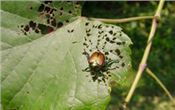Japanese Beetles Will Lay Next Year’s Eggs In Grass, Not This Year’s Infested Fields

Japanese beetles enjoy dining on more than 400 different plant species.
Photo: Chuck Bargeron, University of Georgia, Bugwood.org
COLUMBIA, MO.
Large numbers of Japanese beetles in corn and soybean fields this year have farmers concerned that those fields will be infested again next year.
But that is not likely, says retired University of Missouri entomologist Ben Puttler, because Japanese beetles do not lay eggs where they feed.
They feed in corn and soybean fields but lay eggs in turfgrass and pastures, he says. Grassy areas provide a desirable habitat with no effective natural enemies.
MU Extension soybean specialist Bill Wiebold agrees. “Just because you see heavy feeding in soybean and cornfields, it doesn’t mean that is where they lay their eggs.” The exception might be a field with large amounts of grassy weeds.
Wheat fields may differ, Wiebold says. Growers who change from grass to wheat may see a problem next year, but it is not likely.
Extension agronomists and entomologists report Japanese beetle numbers peaked in mid-July in most of the state.
Wiebold suggests farmers continue to scout soybean fields for Japanese beetle thresholds. If needed, follow control guidelines from MU's Integrated Pest Management program at ipm.missouri.edu.
Most Missouri corn is past silking stage, when beetles cause damage that reduces pollination and yield. Corn past this stage does not need treatment.
Japanese beetles start as larvae called grubs. They live in the soil below ground. Grubs damage plant roots by chewing them. Adult beetles, which emerge from the soil in early June, defoliate soybean leaves and clip corn silks. They also damage other plants and ornamentals.
Japanese beetle first appeared in the United States in 1916. It likely arrived from Japan through exotic iris plants. It appeared in Missouri in the 1930s but was found primarily in urban settings until the 1990s, when it appeared in rural areas. ∆